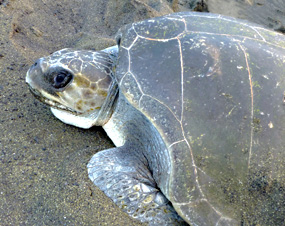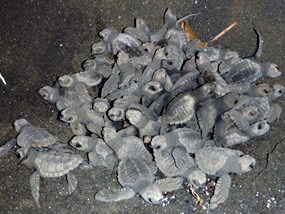|
You are viewing ARCHIVED content published online before January 20, 2025.
Please note that this content is NOT UPDATED, and links may not work. For current information,
visit https://www.nps.gov/aboutus/news/index.htm.
Contact: Mardie Lane, Park Ranger, 808-985-6018 Contact: Will Seitz, Turtle Recovery Project Coordinator, 808-985-6090

NPS Photo Hawai'i Volcanoes' Hawksbill Turtle Recovery Project marked its 21st anniversary with a stellar nesting season. For nine months, forty trained and experienced volunteers protected 40 nests of thirteen endangered sea turtles at six beaches along the southern coast of Hawai'i Island. Their efforts paid off big time—an estimated 4,000 hatchlings made it safely to the sea, but the story doesn't end there. Late in the season, two volunteers witnessed a rare sight. As they combed a beach at dawn for signs of hawksbill nesting, they happened upon a sea turtle laying eggs in the sand. However, this small turtle with her heart-shaped shell was neither a hawksbill nor the more common green. The turtle was an olive ridley and these fortunate volunteers were witness to only the fourth documented olive ridley nesting event in Hawai'i. But perhaps more fortunate than the volunteers, was the turtle. She had dug a nest and deposited her eggs in a tidal inundation zone. Against a backdrop of rising tide and crashing surf, the volunteers knew they had to move the eggs to higher ground before the nest washed away. 
NPS Photo Under supervision of the program's turtle biologist, the volunteers excavated the nest and placed the 88 ping-pong ball sized eggs into a container. They then constructed an egg chamber inland near a patch of morning glory and gently re-buried the eggs in volcanic sand. For fifty-six days the eggs incubated. Throughout, project volunteers maintained a vigil, protecting the nest from feral cats and mongooses, and informing beachgoers of its significance. Then one starry night, 76 olive ridley hatchlings clambered out of their nest, across the sand, and into the sea. Four more emerged over the next few days. The volunteers' dedication ensured the doomed nest of a threatened species survived. Olive ridleys occasionally stray into Hawaiian waters. More typically, they're found in the eastern Pacific off Mexico and Central America and are best known for arribadas, their behavior of synchronized nesting in mass numbers. Mass numbers! For Hawa'i Volcanoes' turtle volunteers, that's hard to imagine. Their fortuitous encounter with just one olive ridley was the icing on the cake of an incredible season. |
Last updated: February 28, 2015
